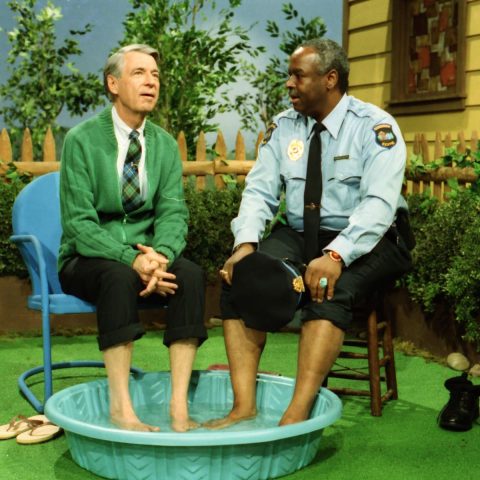
Fred Rogers was a Presbyterian minister who is best remembered for his pioneering work in children’s television as Mister Rogers of Mister Rogers’ Neighborhood. Over the course of thirty-one years and 865 episodes, he communicated powerful lessons about how to love our neighbor. One such episode was both beautiful and very controversial.
Four months after the assassination of Dr. Martin Luther King, Jr., Rogers invited Francois Clemmons, a descendent of slaves and sharecroppers from Birmingham Alabama to play the role of a police officer on his show. Clemmons became the first African-American with a recurring role on a children’s television series. Though innovative, this was not the controversial part. Rogers pressed the social conventions of the time further.
On episode 1065, a few months after Clemmons’ debut, Rogers invited viewers to be his neighbor, as usual. However, instead of putting on his cardigan, he said it was a hot the day and thus proceeded to go outside to put his feet in a pool of cold water. In his front yard he filled a small plastic pool with water and began to soak his feet. Soon Officer Clemmons dropped by for a visit and Mr. Rogers invited him to share the pool with him. Clemmons quickly accepted, rolled up his pant legs of his uniform, and placed his very brown feet in the same water as Rogers’ very white feet.
Today, this small gesture may seem insignificant, but in 1969, it was unimaginable. Like public fountains, public transportation, and public schools, the public pool had become a battleground of racial segregation. Beginning in the 1920s, public swimming pools became accessible like never before. However, during the Jim Crow era, blacks and whites could not swim together. Many feared that African-Americans carried communicable disease and contaminated the water.
What Mr. Rogers did was as powerful and shocking in the 1960s as it would have been for Jesus’ followers (Jews and Gentiles, rich and poor, male and female, slave and free) in the first century to come together and share table fellowship. The importance of table fellowship in Ancient Near Eastern culture is often underestimated by the modern reader of the Bible. Slaves did not eat at the same table as their masters, the rich did not eat with the poor, and the Jews did not eat Gentiles. Because society functioned very much like modern day caste systems, fear of contamination was one of several factors that created this divide.
The charge against Peter after his encounter with Cornelius was not that he baptized uncircumcised Gentiles, although that may have been included in the circumcision party’s criticism, but that he had “eaten” with them (Acts 11:3). Jesus was criticized for sharing a meal with “tax collectors and sinners” (Matt 9:10). Paul rebuked Peter for withdrawing from table fellowship with Gentiles "for fear of the circumcision faction" (Gal 2:11-14).
What Mr. Rogers did was in harmony with the example of Jesus, who seems to have ignored the social customs of the day. He saw all people as humans created in God’s image. He shared a table with tax collectors and Pharisees. He envisioned a time when Gentiles would eat with Abraham, Isaac and Jacob in the kingdom of heaven (Lk 13:28-29). Today, it is (more) common for Christians to eat at the same table with one another without regard to race, socio-economic status or age. However, our society is just as divided today as it has been in past generations. And eating together at a restaurant or at a church potluck is not necessarily the equivalent of having “table fellowship.”
Paul believed table fellowship was possible even among people who were culturally different and who disagreed on religious matters (Rom 14:1-5). God’s multi-cultural family is in as good a position today as it has ever been to model to the world the powerful message of Jesus’ self-giving love.